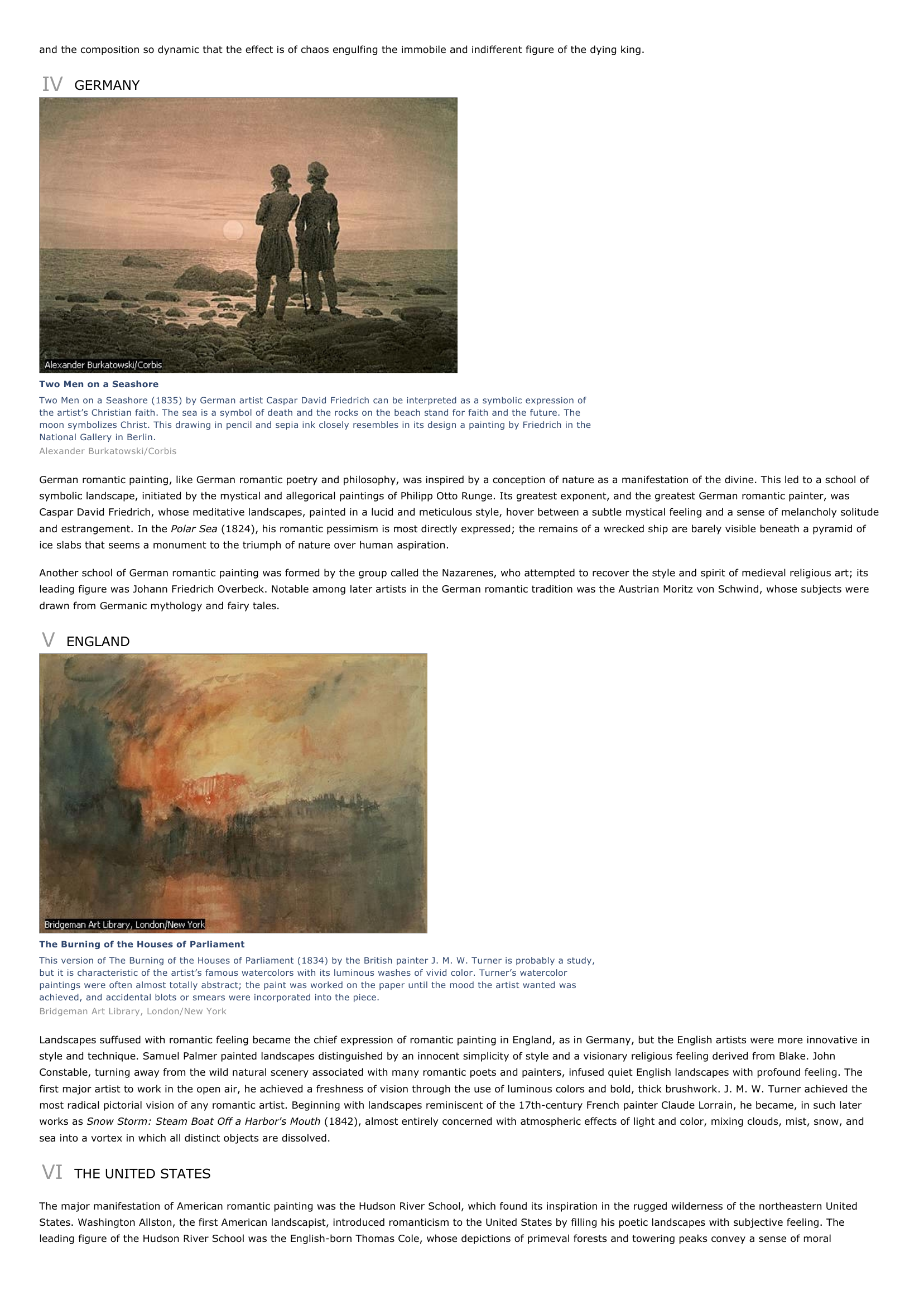Romanticism I INTRODUCTION Romanticism, in art, European and American movement extending from about 1800 to 1850.
Publié le 12/05/2013

Extrait du document


«
and the composition so dynamic that the effect is of chaos engulfing the immobile and indifferent figure of the dying king.
IV GERMANY
Two Men on a SeashoreTwo Men on a Seashore (1835) by German artist Caspar David Friedrich can be interpreted as a symbolic expression ofthe artist’s Christian faith.
The sea is a symbol of death and the rocks on the beach stand for faith and the future.
Themoon symbolizes Christ.
This drawing in pencil and sepia ink closely resembles in its design a painting by Friedrich in theNational Gallery in Berlin.Alexander Burkatowski/Corbis
German romantic painting, like German romantic poetry and philosophy, was inspired by a conception of nature as a manifestation of the divine.
This led to a school ofsymbolic landscape, initiated by the mystical and allegorical paintings of Philipp Otto Runge.
Its greatest exponent, and the greatest German romantic painter, wasCaspar David Friedrich, whose meditative landscapes, painted in a lucid and meticulous style, hover between a subtle mystical feeling and a sense of melancholy solitudeand estrangement.
In the Polar Sea (1824), his romantic pessimism is most directly expressed; the remains of a wrecked ship are barely visible beneath a pyramid of ice slabs that seems a monument to the triumph of nature over human aspiration.
Another school of German romantic painting was formed by the group called the Nazarenes, who attempted to recover the style and spirit of medieval religious art; itsleading figure was Johann Friedrich Overbeck.
Notable among later artists in the German romantic tradition was the Austrian Moritz von Schwind, whose subjects weredrawn from Germanic mythology and fairy tales.
V ENGLAND
The Burning of the Houses of ParliamentThis version of The Burning of the Houses of Parliament (1834) by the British painter J.
M.
W.
Turner is probably a study,but it is characteristic of the artist’s famous watercolors with its luminous washes of vivid color.
Turner’s watercolorpaintings were often almost totally abstract; the paint was worked on the paper until the mood the artist wanted wasachieved, and accidental blots or smears were incorporated into the piece.Bridgeman Art Library, London/New York
Landscapes suffused with romantic feeling became the chief expression of romantic painting in England, as in Germany, but the English artists were more innovative instyle and technique.
Samuel Palmer painted landscapes distinguished by an innocent simplicity of style and a visionary religious feeling derived from Blake.
JohnConstable, turning away from the wild natural scenery associated with many romantic poets and painters, infused quiet English landscapes with profound feeling.
Thefirst major artist to work in the open air, he achieved a freshness of vision through the use of luminous colors and bold, thick brushwork.
J.
M.
W.
Turner achieved themost radical pictorial vision of any romantic artist.
Beginning with landscapes reminiscent of the 17th-century French painter Claude Lorrain, he became, in such laterworks as Snow Storm: Steam Boat Off a Harbor's Mouth (1842), almost entirely concerned with atmospheric effects of light and color, mixing clouds, mist, snow, and sea into a vortex in which all distinct objects are dissolved.
VI THE UNITED STATES
The major manifestation of American romantic painting was the Hudson River School, which found its inspiration in the rugged wilderness of the northeastern UnitedStates.
Washington Allston, the first American landscapist, introduced romanticism to the United States by filling his poetic landscapes with subjective feeling.
Theleading figure of the Hudson River School was the English-born Thomas Cole, whose depictions of primeval forests and towering peaks convey a sense of moral.
»
↓↓↓ APERÇU DU DOCUMENT ↓↓↓
Liens utiles
- Folk Art I INTRODUCTION Carved Native American Figure This figure of a Native American trapper was carved from a single pine log (about 1850-1890).
- Michelangelo I INTRODUCTION Michelangelo (1475-1564), Italian painter, sculptor, architect, and poet whose artistic accomplishments exerted a tremendous influence on his contemporaries and on subsequent European art.
- Cubism I INTRODUCTION Cubism, movement in modern art, especially in painting, invented by Spanish artist Pablo Picasso and French artist Georges Braque in 1907 and 1908.
- Mesopotamian Art and Architecture I INTRODUCTION Mesopotamian Art and Architecture, the arts and buildings of the ancient Middle Eastern civilizations that developed in the area (now Iraq) between the Tigris and Euphrates rivers from prehistory to the 6th century BC.
- Native American Art I INTRODUCTION Native American Art, the visual works crafted by indigenous people of North America, starting after their arrival on the continent thousands of years ago and continuing until the present.








